CLAVERING
RECORDER’S
REPORT 2009
HISTORY DAY
Having had a big exhibition the year before, a much smaller one was mounted in January 2009, this was specifically to raise some money for Stop Stansted Expansion. The History Day was well attended and produced further contributions to the local history collection. As we had recently been given some school archives, these were a particular focus and former pupils and teachers of the school were among the visitors. As a result of donations, a sum was sent to SSE. The Recorder also, at the request of SSE, researched and wrote a landscape report on the heritage of the countryside threatened by the Second Runway plan.
UTTLESFORD HISTORY FAIR
The Clavering Landscape History Group put on display its Clavering Castle history boards and a display of pottery and albums of the project at the Uttlesford History Fair in March. This was an enormous success with numerous villages taking part and was organised by the Recorders of Uttlesford History, following the example of the Clavering exhibition in 2008.
HISTORY NEWSLETTER
The twice-yearly history newsletter, formerly confined to members of the History Group, is now sent round to the entire village. The parish council generously adds it to their monthly newsletter so it costs nothing to circulate apart from photocopying for the postal copies. This helps to build up interest in local heritage and share new information.
LANDSCAPE HISTORY GROUP (CLHG)
Having completed Project Castle the year before, the decision was made not to pursue any further archaeology on the castle site at present, since English Heritage will not allow any excavation. We have however added a resistivity survey kindly done for free by Cambs Rhee Search, and in the winter we still organise work parties to prevent undergrowth taking over the castle mound and open up the view of the site from the churchyard. Other group events were the AGM, the stall at Uttlesford History Fair and the Christmas meeting. Apart from this, our two other projects were continuing as below.
CLHG ORAL HISTORY PROJECT
 The Oral History Project continued throughout the year, organised by two CLHG members, Joy Barrow and Jane Laing and is resulting in a growing collection of CD recordings of the older villagers, which is enormously valuable. In addition one of the visitors to the exhibition returned later to record her memories of being an evacuee in Clavering during the Second World War. A particularly interesting tape was made of the shopkeepers Maru and Manisha Visana (see photo), who run the M & M Supermarket in Clavering, and enabled us to learn a lot about their background and how they came to Clavering 30 years ago. The Oral History Project continued throughout the year, organised by two CLHG members, Joy Barrow and Jane Laing and is resulting in a growing collection of CD recordings of the older villagers, which is enormously valuable. In addition one of the visitors to the exhibition returned later to record her memories of being an evacuee in Clavering during the Second World War. A particularly interesting tape was made of the shopkeepers Maru and Manisha Visana (see photo), who run the M & M Supermarket in Clavering, and enabled us to learn a lot about their background and how they came to Clavering 30 years ago.
The main problem with the project is finding people to transcribe the tapes but a number of volunteers are helping with this – it takes at least seven hours to transcribe one hour of tape using a foot pedal we have purchased to go with the group’s recording machine. Joy Barrow has also been successful in transferring to CD older recordings from mini-tapes and cassettes that were made by Eileen Ludgate and Jacqueline Cooper. Eventually we plan to produce a printed booklet of each interview to present to the interviewee and sell to the villagers interested.
FIELDWALKING PROJECT

For the second year, the CLHG undertook a fieldwalking project organised by a member, Stuart Moore with up to a dozen participants, some from other villages. We walked part of two arable fields in between harvest and re-sowing and are grateful to the local farmer for permission to do this. In both cases we were investigating cropmarks. We gathered hundreds of sherds reflecting the prehistoric, Roman, medieval and post-medieval uses of these fields. We are also grateful to Carolyn Wingfield of Saffron Walden Museum who helped identify a selection of the best material. Stuart produced a number of diagrams and maps interpreting the finds. The main problem is storing the huge amount of material that is found on such exercises, but fieldwalking is well worth doing and always adds to our knowledge of the earlier undocumented history of the area.
ALLOTMENTS CENTENARY
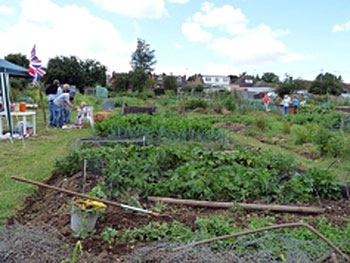 Through borrowing the early parish council minutes for scanning, I discovered that the Clavering allotments would be 100 years old in 2009-10 season. The allotment holders got together and organised a centenary open day – the first such event ever held. John Banks made a video interviewing allotment holders and this was sold to raise funds, and a copy added to the archives. An article about the allotment history appeared in the Herts & Essex Observer nostalgia pages. Through borrowing the early parish council minutes for scanning, I discovered that the Clavering allotments would be 100 years old in 2009-10 season. The allotment holders got together and organised a centenary open day – the first such event ever held. John Banks made a video interviewing allotment holders and this was sold to raise funds, and a copy added to the archives. An article about the allotment history appeared in the Herts & Essex Observer nostalgia pages.
FAMILY HISTORY
Like all Recorders, I deal with a constant stream of family history and other enquiries, many of them from Australia. As the email group of Australian researchers has grown to over 50, at my suggestion they have set up a special Facebook site devoted to Clavering descendants in Oz. In this way they can share information and help each other, as they often turn out to be descended from families related to each other when their ancestors emigrated from Clavering in the 1850s. Many of these genealogists give information back to Clavering, for instance descendants of the Bonds who were transported in the 19th century have supplied copies of their Australian tickets of leave etc.
LANDSCAPE HISTORY DAY SCHOOL
Dr Nicholas James, a distinguished landscape historian from Cambridge, presented a day school at the village hall on the subject of how to study the prehistoric and Roman landscape. This was chosen to chime in with our field-walking interests and followed in the autumn by our seventh annual landscape history evening class, again with Dr James. The eight sessions were complemented with a four-hour field trip to three places in Cambs and this was fascinating and much enjoyed. Sadly, this was the last time we can have a course organised by Madingley centre as their costs have risen too high to make them viable locally (this is due to the withdrawal of government subsidy for such courses). The classes will continue but will have to be organised independently - however this will make them more affordable.
REV CHARLES MALDEN
An email enquiry from an American researcher concerned a former vicar of Clavering, Rev Charles Malden, who was vicar here for only two years in the 1930s. Before joining the clergy, he had been in the Marines and the researcher told us something we never knew before – that Charles Malden had been one of the first Naval officers to help to pioneer the use of telegraph in its early days. He is writing an article about the subject and promised to give a copy to Clavering archives when complete. Information was supplied from our records but we were unable to find a photograph as he was here a short time. If anyone has a photo, please contact the Recorder.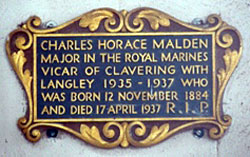
Malden plaque in chancel of Clavering Church
THE CLAVERING POISONER
A young American student, Vicky Nagy visited England to gather material for a proposed PhD on the Essex poisonings of the 19th century, one of which occurred in Clavering (the Chesham scandal 1845-51). I showed her round the places in the village associated with the story. She obtained agreement for her study and was planning a second visit in 2010 and meanwhile has been giving us copies of documents for our archives.
EILEEN LUDGATE MEMORIAL LECTURE
The same subject was chosen for this year’s public lecture in November, given by Fred Feather on the subject of the Clavering and Essex arsenic cases. This was attended by about 60-70 people and donations amounted to £100 which was given to Clavering Church.
CHRISTMAS HISTORY MEETING
The History Group’s Christmas meeting was this year combined with the evening class with Uttlesford Recorders also invited. It was a very good evening with two presentations by the Recorder – one an illustrated history review of the year, the other a Saffron Walden history quiz.
HELPING RESEARCHERS
Local archives have all sorts of uses, for instance the new owner of a house in the village centre wanted to alter its frontage back to how it looked in the 1950s and some photos from our archives gave her the evidence needed to go with her planning application.
SCHOOL ARCHIVES
A phone call from a local newspaper announced the offer of two interesting school archives, donated by a visitor to their offices. The agreement was in return to provide an article based on them for the Walden Local. Both books have been scanned so that a local copy can be retained and the originals sent for safe deposit to the Essex Record Office.
TITULAR BARONY OF CLAVERING
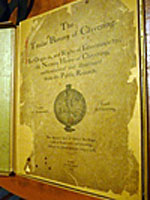 An email from New Zealand enquired about finding a good home for an interesting old book as her sister was emigrating. This book had been in the family’s possession for a very long time and they did not want to take it to NZ. The donor came out from London specially to hand over the book. It turned out to be, as suspected, an original copy of the privately-printed 1890s volume, Titular Barony of Clavering with fine plates of many documents relating to the Clavering family of Durham, who took their name from Clavering in Essex which was one of their possessions, in medieval times: the family was connected to powerful families and to the Crown. Although of no great monetary value, this is a most important book for Clavering to acquire, and as it was falling apart, it was sent to a professional bookbinder who also supplied a purpose-made box to fit. As the History Recorder has no funds for archival work, the cost was donated from evening class surplus. The book was put on display at the Christmas meeting. An email from New Zealand enquired about finding a good home for an interesting old book as her sister was emigrating. This book had been in the family’s possession for a very long time and they did not want to take it to NZ. The donor came out from London specially to hand over the book. It turned out to be, as suspected, an original copy of the privately-printed 1890s volume, Titular Barony of Clavering with fine plates of many documents relating to the Clavering family of Durham, who took their name from Clavering in Essex which was one of their possessions, in medieval times: the family was connected to powerful families and to the Crown. Although of no great monetary value, this is a most important book for Clavering to acquire, and as it was falling apart, it was sent to a professional bookbinder who also supplied a purpose-made box to fit. As the History Recorder has no funds for archival work, the cost was donated from evening class surplus. The book was put on display at the Christmas meeting.
TREASURE TROVE
This medieval brooch was found by a metal detectorist in Clavering and with great generosity he donated it to Saffron Walden Museum. It is 13th century and regarded as treasure trove as it is silver. Our thanks to Carolyn Wingfield, the museum curator, for the photograph.
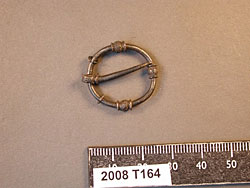
OTHER NEW ACQUISITIONS
People continue to make kind donations of copies of photographs to the collection. Saffron Walden Museum gave the Recorder access to photograph new documents ref the Moat Farm murder that have come to light. Family historians share their photos too and the January exhibition resulted in new acquisitions. An appeal for deeds to scan produced a full set for Hill House in Wicken Road, going back to when it was first built on the waste at the side of the road in 1825. The Deeds of the Manse built 1810 were also borrowed but were too large to be copied in full even on an A3 scanner.
RUTH DATABASE
Work continues to catalogue the collection and scan selectively. Over 1,000 items or sets of items have now been added to the catalogue, but mostly in little detail – this will have to be a later stage. All of Eileen Ludgate’s collection has been catalogued now. As well as the school records, the Recorder also borrowed the early Parish Council minutes and began the long process of scanning them page by page – a very long job but it means that a safe copy will exist on CD and the original can be stored safely. A copy of the Congregational registers has been made as well as other URC archives held by the church. A photographic record has been made of Clavering entries in the Harts Yearbooks in SW Town Library.
LOCAL CAMPAIGNS
A number of heritage campaigns involve Local History Recorders. Discussion continued with the parish council regarding saving the K6 phone box in Skeins Way and they agreed to adopt it. Meanwhile BT announced they wanted to get rid of the other K6 phone box near the Cricketers and at the Recorder’s suggestion, the parish council opposed as the box is listed and is still used. The parish council wrote to BT objecting to the closure of this phone box. The Recorder has also got involved with others in trying to get ancient byways redesignated as Restricted Byways but so far without success – the repair of the damage caused by off-roaders to one of the Clavering byways, Highfield Lane, cost Essex ratepayers £32,000. The Recorder has also corresponded with the parish council about Hill Green, in response to residents’ enquiries about its history. On occasion the Recorder writes letters to Uttlesford DC commenting on planning applications if they appear to have a heritage aspect that might be affected. A list of possible future housing sites put online by Uttlesford DC produced some alarm and led to further discussions with the parish council.
VILLAGE EVENTS
The normal recording of current events continued, with visits made to the 40th anniversary Easter Art Show
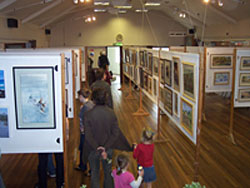
- the May village fete 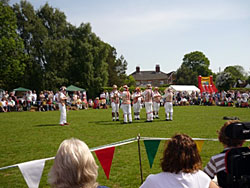
- and its preceding scarecrow competition (hugely popular) 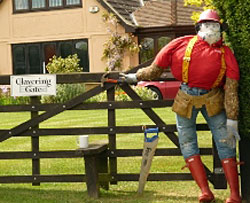
- the July allotments open day, harvest festival and other events to take photographs, as well as numerous local walks recording the changing scene, for instance the felling of a very old but diseased tree in the churchyard and the snow scenes in February 2009. Newspaper cuttings, parish magazines and newsletters and ephemera continue to pile up. Storage is becoming a problem.
FUTURE PLANS
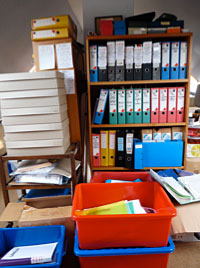 Future plans include an evening class in family and community history; a proposal to excavate a prehistoric/Roman site identified through our fieldwalking - the viability and timing of this depends on funding; the ten-yearly re-enactment of the Beating of the Bounds on 3 May 2010; and the continuation of scanning, cataloguing and conserving the local records, with the eventual aim of establishing a local history facility in Clavering. Future plans include an evening class in family and community history; a proposal to excavate a prehistoric/Roman site identified through our fieldwalking - the viability and timing of this depends on funding; the ten-yearly re-enactment of the Beating of the Bounds on 3 May 2010; and the continuation of scanning, cataloguing and conserving the local records, with the eventual aim of establishing a local history facility in Clavering.
Jacqueline Cooper (email - mrsjacquelinecooper@gmail.com)
Clavering Local History Recorder |

